Unlocking the Future of Real Estate Advertising: Trends and Insights (2022-2024)


Table Of Content
- 1. Introduction
- 2. The Growing Significance of Advertisement in the Real Estate Sector
- 3. Key Advertising Trends in Real Estate Sector
- 4. A Surge in Ad Spends Across Media
- 5. Evolving Media Preferences
- 6. Targeted Campaigns and Seasonal Peaks
- 7. Ad Spend Growth Across Media
- 8. Cross-Media Preferences
- 9. Seasonal and Regional Insights
- 10. Media-Wise Analysis: Spotlight on Key Channels
- 11. The Role of Events and Celebrity Endorsements
Introduction
It has changed a lot between 2022 and 2024 because of the innovations in technologies and the changes in how the audience behaves. Whether one has media platforms, the choice of the right trends of advertisements is the way forward for marketers. Aligned strategy with contemporary shifts will be the real estate brand's way to market attention and, thus, business success.
The Growing Significance of Advertisement in the Real Estate Sector
Advertisements have become the backbone of the real estate industry. Nowadays, in the real estate business, an advertisement is relied upon for catching a potential buyer and investor alone. The greater the effectiveness of the advertisement, the better will be trust and publicity, as well as conveyance of all-important features of property. Traditional media like TV print and digital media channels have never witnessed such demand for innovative strategies. This therefore helps ensure that brands can optimize reach and return on investment by understanding which channels are most impactful, thus ensuring greater success in an increasingly competitive marketplace.
Key Advertising Trends in Real Estate Sector
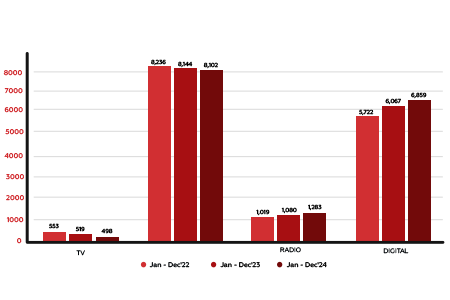
Real estate advertising trends from 2022 to 2024 manifest changes in consumer preference and media consumption. One size does not fit all, as TV, print, radio, and digital each present a different avenue to connect with the audience. Marketers are now directing multiple channels, traditional and digital, to ensure high engagement and effective reach for targeted buyers.
A Surge in Ad Spends Across Media
The advertising spend for real estate has shown a significant rise, both through digital and traditional media. In terms of shares, television still dominates; however, investments in digital, especially in social media and search engines, have been increasing since they offer a high level of precision targeting. Advertisers are shifting focus to ensure their budgets align with consumer behavior's broad yet targeted reach towards prospective buyers.
Evolving Media Preferences
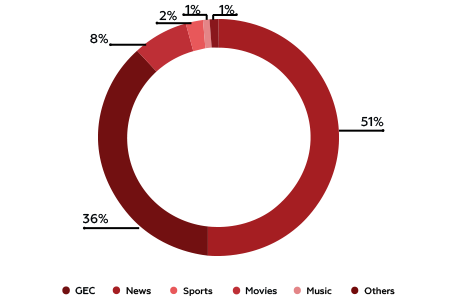
As audience preferences evolve, advertisers are finding more success with cross-platform campaigns. TV’s broad reach continues to dominate, especially for mass appeal, but digital platforms are becoming increasingly important due to their ability to target specific buyer segments. Radio, while once considered a secondary option, is enjoying a resurgence with localized campaigns that cater to specific markets. Print still holds relevance, particularly for hyper-local targeting in high-growth areas.
Targeted Campaigns and Seasonal Peaks
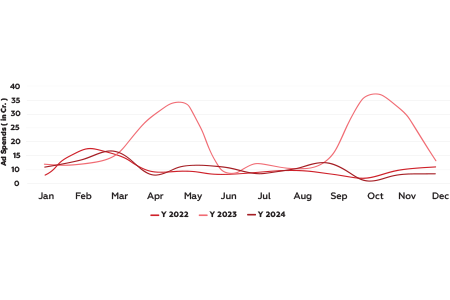
Effective real estate advertising takes advantage of both targeted campaigns and seasonal peaks. Digital channels offer precision, allowing for targeted ads that reach users based on their interests and behavior. Traditional media, like TV and print, tend to see heightened engagement during key seasonal periods, such as festive seasons, which align with increased property buying activities.
Ad Spend Growth Across Media
- Television:
Real estate ad spending on TV grew 88% in 2023 and remained steady in 2024, with news and entertainment channels driving high engagement.
- Print:
Print ad spending grew 34% in 2024, with regional newspapers continuing to dominate ad spending in areas like the North and West Zones.
- Radio:
Radio ads have experienced a resurgence, with localized ads driving strong market engagement. A cost-effective medium, it remains valuable for reaching regional buyers.
- Digital:
Despite a slight decline in 2024, digital ad spending on platforms like Facebook and YouTube continues to thrive due to their targeted reach and visual ad capabilities.
Cross-Media Preferences
Brands in the real estate sector are increasingly adopting cross-media strategies to engage diverse audience segments and optimize reach.
- Print:
By targeting region-specific publications, print campaigns effectively connect with local buyers and enhance brand credibility.
- Television:
A reliable medium for mass appeal, TV advertising ensures broad reach, particularly in prime time, and is essential for building brand trust.
- Radio:
With localized engagement, radio reaches specific markets efficiently, making it a strong choice for regional advertising.
- Digital:
Digital platforms leverage precision tools, allowing brands to engage niche segments through retargeting, immersive formats, and year-round campaigns.
Seasonal and Regional Insights
Seasonality plays a crucial role in shaping advertising strategies. Real estate ads peak during festive seasons, when cultural and financial readiness to invest align. Traditional media like TV and print see heightened engagement from August to November, driven by increased buyer activity. Digital, however, remains steady throughout the year, making it a consistent tool for maintaining visibility.
Media-Wise Analysis: Spotlight on Key Channels
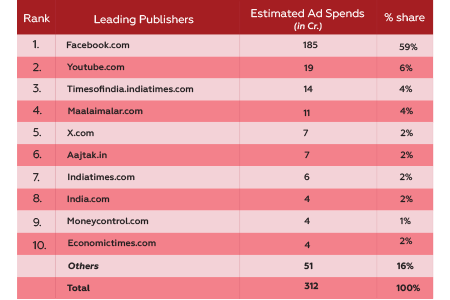
Each media channel brings unique strengths to real estate campaigns, enabling advertisers to craft tailored strategies for different objectives.
- Television:
Dominates with mass reach and emotional resonance, especially during prime-time slots.
- Print:
Effective for regional targeting, ensuring hyper local campaigns resonate with specific markets.
- Radio:
A cost-effective choice for localized messaging, particularly in key urban centers.
- Digital:
Provides unmatched precision in targeting and offers tools for constant engagement, making it ideal for ongoing brand visibility.
The Role of Events and Celebrity Endorsements
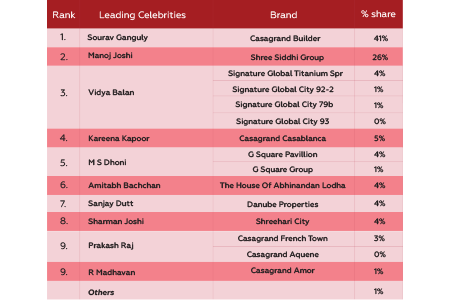
Events and celebrity endorsements are an important part of real estate advertising campaigns. The credibility and emotional appeal that celebrities bring to campaigns increase brand recognition and trust among the target audience. Real estate brands can easily tap into the established fanbase of these celebrities by partnering with them, which creates a deeper connection with potential buyers.
Besides media, real estate marketers are now resorting to live events to reinforce brand presence. Such events allow for face-to-face contact: potential customers experience the property or the brand firsthand. Finally, brands can connect with key influencers and celebrities, thereby increasing the impact of the campaign.
Celebrity endorsements have, in fact, become a very viable tool in advertising real estate. Sourav Ganguly and Manoj Joshi are some personalities that have contributed to brand identification and emotional linking with the customer. Brands develop trust and high-profile campaigns in the minds of the audience as they associate with public figures highly respected by everyone.
Disclaimer: The information presented has been analyzed by Excellent Publicity and is derived from over 1,50,000 campaigns executed by our team. Additional insights have been sourced from TAM Media Research. While we strive to provide accurate and reliable data, we cannot guarantee its absolute accuracy. Please feel free to contact us if you have any feedback or wish to request modifications. We will review your input and implement the necessary changes within five working days.

